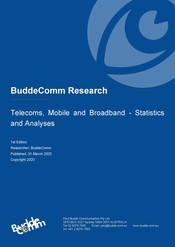Australia - National Broadband Network - Statistics and Analysis

Last updated: 24 Oct 2018 Update History
Report Status: Archived
Report Pages: 73
Analyst: Phil Harpur
Synopsis
Australia’s National Broadband Network (NBN) is delivered via a multi-technology mix (MTM) to homes and businesses including: fibre to the premises (FTTP), fibre to the building (FTTB), fibre to the node (FTTN), Hybrid Fibre Coaxial (HFC), fixed wireless and satellite.
The purpose of the company nbn is to build a nationwide, wholesale-only, high-speed, affordable open broadband network. NBN Co was rebranded as nbn, the company overseeing Australia’s National Broadband Network (NBN) project. As it does not provide telecommunications services to retail customers, the market opened up existing and new licensed RSPs (Retail Service Providers).
The NBN will increase Australia’s GDP by up to $10 billion and create up to 150,000 new jobs nationally in the digital industry by 2021. The establishment of businesses in areas served by the NBN so far grew at twice the rate of the national average and five times the pace of regions without the network.
NBN Co announced plans in 2018 to be able to more efficiently deploy fibre to the curb (FTTC) services instead of its more conventional DSLAM-based fibre to the basement (FTTB) services when connecting smaller multi-dwelling units (MDUs).
The industry has started to seriously question the regulatory environment around the NBN. The smaller players believe they are in danger of being squeezed out of the market through complex and expensive NBN wholesale offerings. These same arrangements also mean that the end-users are not receiving the benefits of high-speed broadband in an affordable form.
NBN Co has revealed plans to begin deploying “skinny fibre” (thinner fibre cables) in new housing estates from 2017-2018.
The National Broadband Network announced it would entirely abandon its plan to use the Optus Hybrid Fibre Coaxial (HFC) network to deliver high-speed broadband. NBN will however still be using Telstra’s more extensive HFC network as planned.
Key developments
- NBN Co deploy fibre to the curb (FTTC) services instead of DSLAM-based fibre.
- NBN Co will deploy "skinny fibre" (thinner fibre cables)
- The NBN will increase Australia's GDP by up to $10 billion.
Companies mentioned in this report:
NBN; Austar; Ericsson; Visionstream; Optus, iiNet, AUSTAR, Foxtel, Neighbourhood Cable, TransACT. Optus, Telstra, nbn (NBN Co), LBNCo, OPENetworks, OptiComm, RedTrain, Pivit, Fibercorp.
Related Reports
- Australia - Telecoms, Mobile and Broadband - Statistics and Analyses
- Australia - Data Centre Market
- South Pacific Islands - Telecoms, Mobile and Broadband - Statistics and Analyses
- Samoa - Telecoms, Mobile and Broadband - Statistics and Analyses
- Papua New Guinea - Telecoms, Mobile and Broadband - Statistics and Analyses
- New Zealand - Telecoms, Mobile and Broadband - Statistics and Analyses
- French Polynesia - Telecoms, Mobile and Broadband - Statistics and Analyses
- New Caledonia - Telecoms, Mobile and Broadband - Statistics and Analyses
- Vanuatu - Telecoms, Mobile and Broadband - Statistics and Analyses
Share this Report
TMT Intelligence
A platform to scale your intelligence tasks
Monitor critical insights with our AI-powered Market Intelligence Platform gathering and analyzing intelligence in real time. With AI trained to spot emerging trends and detect new strategic opportunities, our clients use TMT Intelligence to accelerate their growth.
If you want to know more about it, please see:
Research Methodology
BuddeComm's strategic business reports contain a combination of both primary and secondary research statistics, analyses written by our senior analysts supported by a network of experts, industry contacts and researchers from around the world as well as our own scenario forecasts.
For more details, please see:
More than 4,000 customers from 140 countries utilise BuddeComm Research
Are you interested in BuddeComm's Custom Research Service?
Hot Topics
News & Views
Have the latest telecommunications industry news delivered to your inbox by subscribing to BuddeComm's weekly newsletter.